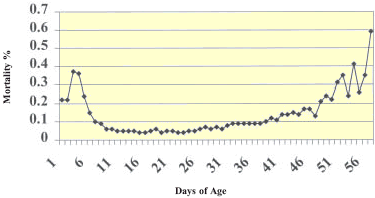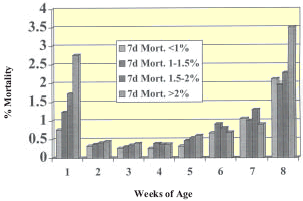



Mortality Patterns Associated with Commercial Broiler Production
By G.T. Tabler, I.L. Berry and A.M. Mendenhall at the University of Arkansas's Avian Advice - Flock mortality has a major influence on size of the settlement check after harvest and so is one of the greatest worries of any broiler grower. While differences in breeder flock status, genetic strain, hatchery conditions and management practices mean that two consecutive flocks on a particular farm will seldom have similar mortality patterns, the examination of data from numerous flocks can help to identify specific mortality patterns.Introduction
These patterns allow the comparison of mortality trends in the current flock with historical averages. Recently compiled data from our facility may assist you in identifying mortality patterns commonly associated with commercial broiler production.
Facilities and Management Practices
Mortality data were gathered from 38 consecutive flocks of straight run broilers from October 1996 through June 2003 at the Applied Broiler Research Unit. Half of the 38 flocks were grown to 49 days or less while the other half were grown longer than 49 days. The youngest flock was 39 days at harvest with the oldest harvested at 57 days. All flocks were grown for the same integrator under a standard broiler industry contract. Management practices were the same in all houses. Flocks consisted of various genetic strains and breeder flock ages throughout the study, a common industry practice. The four houses on the farm were each 40 x 400 ft.; two with tunnel ventilation and two cross-ventilated. Berry et al. (1991), Xin et al. (1993) and Tabler and Berry (2001) provide a complete description of the houses involved.
Mortality Patterns
The average mortality patterns observed are shown in Figure 1. (See page 2.) Since no
significant differences were observed between houses, only average date are shown. These data
show that broiler mortality usually peaks at approximately 3 to 4 days after placement, declines
until approximately day 9 or 10 then stabilizes until approximately day 30. After day 30 a
gradually increase is seen until approximately day 40 to 45. After day 45, mortality rates
increased until harvest. The pattern is similar to results reported by Xin et al. (1994); however,
their data indicated a slightly higher 2-week mortality, somewhat lower 8-week mortality, with
similar 6-week mortality on 10 consecutive flocks of 8-week male broilers.

Early Mortality and the Importance of Culling
The peak in mortality at day 3 to 4 may coincide with the disappearance of the yolk sac in the intestine of chicks. Chicks that for whatever reason do not begin to eat and drink may survive the first few days with the yolk sac alone, but once this food source is depleted the chick will soon perish. At 3 to 4 days of age experienced growers can usually distinguish chicks that are destined to succumb from those that are off to a good start by their size and vocalization patterns.
While chicks that are off to a good start are active, avidly eating feed and move away quickly when approached, cull birds will often stand by themselves, chirp and refuse to move away as the grower comes near. When cull birds are found they should be immediately removed and humanely destroyed by an approved method (Watkins, 2003). The longer these birds remain in the flock the more detrimental they become to the feed conversion ratio. In addition, removing cull birds at this early stage will improve flock uniformity, making management of feeder and drinker height much easier as the flock ages. It is extremely difficult to properly manage feeder and drinker height with numerous bird sizes in a house. However, culling programs vary among integrators so consult your service technician
before implementing dramatic changes to your current culling practices.
The data in Figure 2 illustrate the relationship between early mortality and late mortality. Flocks that lost the most birds early, tended to lose the most birds late. In addition, when first week mortality was high, uniformity was often a problem, and feed conversions were frequently less than desirable. These flocks required additional time, effort and a management skill to achieve an acceptable level of performance. However, it should also be noted that only a small percentage of flocks had a first week
mortality of ≷2% and those flocks were generally not back-to-back.

Late Mortality
Mortality after about day 45 was most likely due to heart attacks, ascites and leg problems since these diseases generally increase dramatically late in the life of the flock. Clearly death losses late in the flock can have serious negative consequences on both feed conversion and pounds of sellable meat. To some degree, these problems can be reduced with proper feeding and lighting programs. Integrators may change these programs periodically so stay in close contact with your field service technician as to the proper program to follow.
Summary
Mortality in broiler flocks represents lost income to growers and integrators alike. Even though mortality is an everyday part of broiler production, growers should tailor management programs to reduce its overall effect on flock performance. An aggressive culling program early in each flock that humanely removes substandard birds as they appear can improve overall flock uniformity and performance with a minimal negative effect on feed conversion ratio.
Allowing cull birds to remain in a flock increases the difficulty in feeder and drinker management throughout the flock. Also, if these birds succumb or are culled late in
the flock, they have a much greater negative impact on feed conversion because they have eaten more feed (which is now lost) than they would have if removed at 1 or 2 weeks of age. Management programs later in the flock are often designed slow growth slightly to reduce late mortality due to ascites, heart attacks, and leg problems.
References
Berry, I. L., R. C. Benz, and H. Xin. 1991. A controller for combining natural and mechanical ventilation of broilers. ASAE
Paper No. 914038. Amer. Society of Ag. Engineers, St. Joseph, MI.
Tabler, G. T., and I. L. Berry. 2001. Applied Broiler Research Unit Report: Ten-year summary of broiler production results.
Ark. Farm Bureau Young Farmers and Ranchers Conference, Hot Springs, AR. Aug 3-4.
Watkins, S. E. 2003. Animal welfare audits: What to expect and how to be prepared. Avian Advice 5(4):6-8.
Xin, H., I. L. Berry, T. L. Barton, and G. T. Tabler. 1993. Sidewall effects on energy use in broiler houses. J. Appl. Poult. Res.
2:176-183.
Xin, H., I. L. Berry, T. L. Barton, and G. T. Tabler. 1994. Feed and water consumption, growth, and mortality of male broilers.
J. Poult. Sci. 73:610-616.

Source: Avian Advice - Spring 2004 - Volume 6, Number 1








